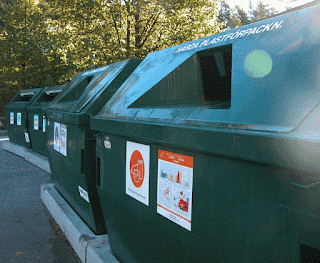For us, Sweden has long had this sort of recycling arrangement, where shopping, which generates packaging, is associated with recycling that packaging. Almost all other products can be taken to specialist recycling centers (called återvinningscentraler), where there are huge industrial-sized skips. There is a skip for clean landfill (soil, concrete, etc), one for metal, one for wood, etc. We also have two curb-side bins per household, to put out fortnightly, one for non-recycling and one for organic matter (ie composting).
Interestingly, the European Union is in the process of wisely adopting roughly this Swedish scheme of recycling. This emphasizes just how important recycling is in the modern world. We should therefore be asking ourselves what the wine industry is doing to take an active part in this particular part of society.
The leading role of the Nordic countries (Sweden, Denmark, Norway, Iceland, Finland) has actually been acknowledged within the wine media. For example (Can the Nordic monopolies turn the drinks world green?): *
Scandinavia’s five alcohol monopolies have launched a joint program to combat climate change.Clearly, the major issue here is the wine bottles. There is a high environmental cost to making them in the first place, and also a high cost to recycle and re-make them. The massive temperatures needed for both making and recycling glass bottles mean that they have what is called a Large Carbon Footprint (The problem with wine bottles). Indeed, the glass represents a huge percentage of the wine industry’s global carbon footprint (Assessing the carbon impacts of wine production), and we have long known this (The environmental cost of a bottle of wine).
Across all of these regions, there is a high consumer awareness of environmental issues, and recycling rates are over 90%, rising to 98.2% for the nature loving Norwegians. Finland’s recycling rate has been encouraged by a deposit-refund system (10 cent to 40 cent depending on the size). The return ratios are with cans at 97%, PET-bottles 90% and glass bottles 98%.
Historically, until the late 1990s, the Nordic monopolies had their own refund systems on wine bottles that were then cleaned and refilled. The cheap, low–quality wine they contained, and the packaging model, went out of fashion, but there are now suggestions that it might be revived. According to Maritta Iso-Aho, Alko’s Communications Director: “All means are on the table, and we have discussed the possibility to re-introduce the concept.” But the the discussions are evidently still only in the very early stages.
The re-filling of bottles, as discussed above, is an obvious way forward for the wine industry, although it has rarely been tried. However, the recent London Wine Fair was to focus on sustainability, with bottle reuse scheme and education sessions, as a first data-gathering step. Unfortunately, there seem to be many objections that have been raised, as discussed by Australian Grape & Wine, for example, with regard to proposals by Australian state governments and territories to extend container deposit schemes to include glass wine bottles (We need to change the narrative around container deposit schemes).
In terms of manufacturing, rather than re–using, there are several current ways of moving forward (6 wine trends impacting climate change and consumer taste), including the two most obvious ones:
- Trend #1 — More light–weight wine bottles
- Trend #2 — The growing use of alternative wine containers
For the second one, most people think of bag-in-box and aluminium cans, when considering alternative wine containers to glass, but there are other packagings available. I have reviewed this topic before: How do so-called alternative wine packagings compare? For another discussion, see: Alternative wine packaging: thinking inside the box.
The carbon emissions of all of these various alternatives are compared in this graph, which should make the ultimate environmental situation clear to you.
The main issue for we consumers, of course, is the quality of the wine put into these containers. Sadly, in terms of alternative packaging, there has been considerable discussion about: Is the wine industry ready to utilise alternative packaging?
This last conclusion seems to me to be very sad, actually. More optimistically, much of the wine industry has already gotten used to screw-caps, so they can probably get used to other things as well.There seem to be two camps when it comes to alternative packaging in wine. One believes change is not just inevitable, but essential, the other is still firmly of the view “if it ain’t broke ...”.
The former camp argues the wine industry needs to act if it is to be in tune with growing consumer demand to buy products that are sustainable, environmentally healthy and help cut carbon emissions. Wine brands need to adapt with these concerns in mind.
In the latter camp are those who can’t yet see the reason to change a supply chain, dominated by glass packaging, that has worked well for so long, and is so entrenched in established wine drinkers’ modus operandi.
This is a recurring theme in the alternative packaging movement, that it is the major retailers that hold all the cards and it is up to them to take the plunge to effect change. Andrew Ingham explains: “Wine doesn’t lead, it waits. It waits for the retailers to tell them what they want, and then it responds, It’s such a shame that getting a supermarket listing is the bottleneck to innovation and change”.
* I have discussed before the seemingly endless American tendency to call the Scandinavian (government-owned) retail stores “monopolies”: Why are there wine monopolies in Scandinavia? A bigger problem, if there is one, seems to be the three-tier system of alcohol distribution and sales in the USA (The American wine media has failed their audience).




No comments:
Post a Comment